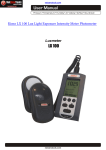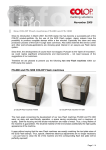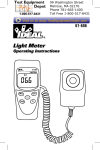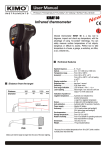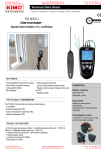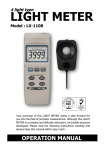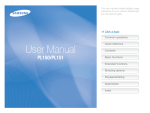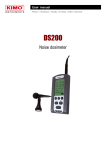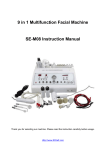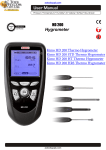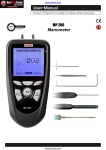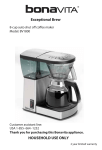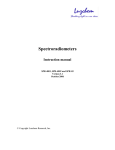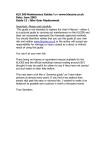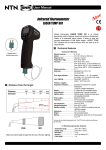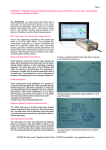Download LX 100 - Interautomatika
Transcript
Luxmeter LX 100 Table of content 3 I – Introduction........................................................................................................................................4 II – General information.......................................................................................................................4 Photometric unities..................................................................................................................................................................................4 Use...................................................................................................................................................................................................................5 III – Operating principle........................................................................................................................6 Keyboard presentation...........................................................................................................................................................................6 Two groups of display..............................................................................................................................................................................6 IV – Configuration..................................................................................................................................7 Screen control............................................................................................................................................................................................7 Calibration....................................................................................................................................................................................................7 About – Languages - Lux/fc.................................................................................................................................................................7 V – During measurement....................................................................................................................8 Range.............................................................................................................................................................................................................8 Illuminance...................................................................................................................................................................................................8 Averaged illuminance...............................................................................................................................................................................8 Relative illuminance..................................................................................................................................................................................9 VI – Operating information.................................................................................................................10 Over-range....................................................................................................................................................................................................10 Power.............................................................................................................................................................................................................10 VII – Maintenance..................................................................................................................................10 Servicing........................................................................................................................................................................................................10 Regular checking.......................................................................................................................................................................................10 Substitution of batteries - Adaptors.................................................................................................................................................10 VIII – Main specifications....................................................................................................................11 Range details..............................................................................................................................................................................................11 Specifications..............................................................................................................................................................................................11 Standard reference..................................................................................................................................................................................11 IX – Metrology.........................................................................................................................................12 Traceability...................................................................................................................................................................................................12 Calibration....................................................................................................................................................................................................12 X – Delivery and packaging.................................................................................................................12 4 I – Introduction LX100 instrument is a portable instrument totally automatic built for the measurement of illuminance. It displays result in Lux or foot candles (footcandle) and provides: Instantaneous measurement ● Display illuminance for local measurements With timed measurement : ● Illuminance min/max values display ● Illuminance averaged value calculation In addition : ● It includes a pause function to eliminate any unrepresentative and unwanted illuminance or just to memorize on the screen a local result. ● It allows a relative measurement to reference point for the quantification of increase illuminance or decrease illuminance. Data are saved when the instrument is stopped or in case of battery failure.. Its sensor is composed by a silicium photodiode, which spectral response is the photopic curve according to CIE standard. LX 100 instrument is mainly an efficient and easy- to-use instrument : with small size, it has a large display with a resolution of 64*128 pixels, and involving a very high technology. II – General information Photometric values Photometric values are values which allows to define the action of electromagnetic radiation on visual function of the eye of an observer. The average standard eye, adopted by theCIE (International Commission on Illumination), is defined by a function on spectral efficiency which is relative to spectral for daytime vision or photopic. Photopic curve of spectral sensitivity of human eye during diurnal vision Luxmeter Photometer destined to measurement of illuminance, it is equipped with a photo-electric detector and very often a silicium photodiode coupled with a filter for modify its response to be close-in the most possible of the function of reference V(λ) defined in the CIE. 5 Luminous flux The luminous flux of a source is the assessment, according to the sensitivity of the eye, of the amount of light radiated throughout the area by this source. It is expressed in lumens (lm).. Luminous intensity The light intensity is the luminous flux emitted per unit of solid angle in a given direction.. It is measured in candelas, equivalent to 1 lm / sr. Luminance The luminance of a source is the ratio between luminous intensity emitted in one direction and the apparent surface of the luminous source in the considered direction. Luminance is expressed in candelas per square meter (cd/m2). Illuminance Illuminance of a surface is the ratio of the luminous flux received at the area of the surface. Its unit is the lux, equivalent to 1 lm/m2. It is also expressed in footcandle (fc) according the ratio : 1 fc = 10.76 lux. LX100 instrument has been built to measure illuminance , it allows a measurement in lux or footcandle for illuminance levels below 10 lux, with 0,1 lux calculation accuracy and with 1% accuracy beyond until 150000 lux. Use : For each application, it's advisable to control means of measure to obtain valid and consistent results. Means of use of the instrument has at least so much importance on the result than the quality of the instrument. It is imperative to take account of the most important parameters including:: 1. Position correctly the LX100 cell, according to adequate and representative plan of the current study. (eg: workstation) 2. Avoid illumination unrepresentative of the study area 3. Deviate significantly from the cell to avoid mitigation area of illumination. Functions « pause » and « relative level » integrated into LX100 instrument will allow to avoid these different problems. 6 III – Operating principle Keyboard presentation When being switched on, “measurement screen” is displayed . From this screen, the operator has access to three others screens by pressing on keyboard; return to measurement screen is obtained by activating . Function keys Directly associated with texts to displayed shown above on display, they measurement setting. Key “leaves current screen”. Screen key From measurement screens, gives access to other screens On/Off key 1 2 4 3 5 6 Instrument offers 2 groups of screens 1. Screens representing the 3 different modes of measurement Instantaneous Average Relative 2. Configuration screens Brightness Calibration Informations 7 IV – Setting Accessible from principal measurement screen by successive pushes on inform users. key , those different screens allow instrument setting. They also Screen control To optimize display reading, the operator can : 1. Adjust brightness by pressing on + and - function keys. 2. Backlight LCD display for a better reading in a dark place. “No” means backlight is switch off and “Yes” it is switch on. In this last case, battery life is reduced by about 15%. Brightness Calibration Its role is mainly to recall the calibration conditions including the percentage of modification of profit compared to a nominal calibration. It is strongly recommended not to change the instrument calibration, this screen is reserved to the manufacturer or laboratory partner. In case of unwanted push on a key, an alert occurs: Caution modification! . Exit via the keys In case of calibration, please refer to METROLOGY Chapter . Calibration About... Information on origin of manufacture, standard references of the instrument and dates of last and next audits.. By Pressing or English. French and English keys you can choose language : French About – English A press on lux or fc keys allows the choice measurement unit : Lux or Footcandle. Note : unit, lux or fc is independent of the used language. About - French 8 V – During measurement Range The digital processing of the instrument avoids for users choice of a range of measurement, LX100 instrument displays results of measurement in lux or fc on all of its dynamics. To cover the whole field, the screen automatically presents the different formats and units. Lux mode Footcandle mode Illuminance From the start, the instrument measures and displays twice a second the instantaneous value of illuminance expressed in Lux or fc. This value gives information to users about illuminance local conditions. ● Min. and max. values completes the screen. ● User can at any time by pressing the keys : : Reset minimum and maximum values : Enable pause : Continue measurement Illuminance Averaged illuminance Measurement principle : From the sampled data, the instrument calculates and displays on the measurement duration : Instantaneous value at rate of two displays per second Average value Max and min values From the start screen, user accesses to the Moy measurement of illuminance on a period controled by stopwatch, he proceeds as follows: 1x Access to Moy screen. Measurement is not launched yet. 1x Launching of the stopwatch, it indicates seconds -minutes-hours-days (max : 03D00H00M00). First values, (average, max and min). During measurement, no other function is accessible. 1x 1x Stop of measurement, ''Reset'' is displayed. In case of poor readability, user can at this moment modify brightness and/or activate backlight. 9 New measurement After recording results in his folder, user can launch a new measurement, he proceeds as follows : 1x : a sign RESET ? alerts the user of the future reset of memory backup. In case of change of mind, pressing or inhibits the action. 2x : Memory is erasing , visualized by the progress bar. Memory is erased, the operator can launch a new measurement. Reset ? Erased data Stop of the instrument In case of stop of the instrument, intentionally or accidentally (low battery), results are saved automatically and systematically presented to the user before the launch of a new measure. Relative illuminance Principle : To find the contribution on measurement result by the contribution or removal of a light source, LX100 instrument allows a relative measurement from an existing situation. For example: knowing the impact of deleting or adding a lighting (neon tubes) in a room. Proceed as follows : From the start screen, user accesses to the measurement of the illumination 1x Inst then 1 x Moy Rel : access to the screen. The function is not yet launched. Moy 1x Zr Value displayed at the top of the screen represents instantaneous illuminance Fluctuating instantaneous illuminance Relative illuminance : Press Zr key – screen shows: Down : the instantaneous value of illuminance (598.9 lux here), it will serve as reference. It remains fixed and stored. ● ● Reference illuminance At the top : the value of fluctuating instantaneous illuminance (1268 lux here) In the middle : in the panel marked R, it is the difference between instantaneous value displayed at the top and reference value stored down. This value can be positive or negative according to fluctuations of illuminance compared to the moment of memorization of the reference value ( Zr key ) Example 1 ● Fluctuating instantaneous illuminance Relative illuminance Reference illuminance Example 2 10 VI – Running informations Over-range Under conditions of measuring range excess, defined at 150,000 lux, an over-range pictogram appears. It comes fleetingly for an illuminance exceeding 150 000 lux . Displayed value will be 150.1 klux. Power source When the instrument is equipped with alkaline batteries, it can operate for 72 hours minimum. A symbol informs the user about electric power remaining. If battery is low, less than 1 bar on the pictogram, the instrument stops measuring, saves current measurement and switches off. VII – Maintenance Servicing The LX 100 conception allows a reduced maintenance, which consists in changing batteries and cleaning the instrument and sensor with a slightly dampened cloth. A particular attention must be paid to the white disc covering the silicon photodiode which surface must not have dirts or scratches Regular checking Like most measuring instruments, it is strongly recommended to regularly control and calibrate LX100 instrument. The sensor sensitivity decreases depending on measurement durations and illuminance intensity. Return to the manufacturer each year will provide necessary metrological traceability. Batteries replacement – adaptors Batteries : To replace batteries, open the back hatch and insert the 3 new batteries of type 1.5 V / AAA-LR3 inside. Warning : respect meaning of batteries. If storage is very long, remove batteries. Adaptor : If necessary for a long period of measurement, use a USB adaptor . Note: when using with an external power, it is recommended to remove batteries from LX100. An internal protection, however, allows to secure all if you forget it. 11 VIII – Main specifications Range details lx value Display Unit lux resolution Minimum accuracy of calculation 0 to 10 0.1 to 10.0 lx 0.1 0.1 lux 10 to 99 10.0 to 99.9 lx 0.1 1% 100 to 999 100.0 to 999.9 lx 0.1 1% 1000 to 999 1000 to 9999 lx 1 1% 10000 to 99999 10.00 to 99.99 klx 10 1% 100000 to 150000 100.0 to 150.0 klx 100 1% fc value Display Unit fc resolution Minimum accuracy of calculation 0 to 1 0.00 to 1.00 fc 0.01 0.01 fc 1 to 99 1.00 to 99.99 fc 0.01 1% 100 to 999 100.0 to 999.9 fc 0.1 1% 1000 to 9999 1000 to 9999 fc 1 1% 10000 to 13940 10.00 to 13.94 kfc 10 1% Specifications Measuring range.......................................from 0,1 to 150 000 Lux from 0.01 to 13940 fc Spectral response.....................................as per standard photopic curve V(λ) NF C 42 -710 class C. Error limit V(λ) (f1) ...................................< 10% True cosine evaluation (f2).......................< 6% Linearity (f3).............................................< 3% Measurement capability...........................3 days – 03D00H00M Display.......................................................Backlit LCD graphic 128x64. Working temperature................................from 0°C to +50°C Storage temperature.................................from 0°C to +50°C Housing dimensions (without sensor)....120x58x34 mm Weight (housing+sensor+battery)...........185 gr Digital electronic.......................................low drift Mini-USB plug...........................................for USB power supply adaptor Power supply............................................3 batteries 1.5V type LR3-AAA Battery life.................................................72 hours min, continuous operation. Electromagnetic compatibility.................according to 89/336/CEE Conformity................................................as per RoHS Standard reference This instrument is based on recommendations and requirements of the NF C 42-710 standard, February 1988, C class 12 IX – Metrology Traceability Calibration of this instrument was performed to determine calibration coefficient with a standard luxmeter measured under controlled lighting, usually an illuminant type A according to the CIE. The calibration coefficient expressed in percentage is filled. A calibration certificate is provided with the instrument. Traceability Calibration Reserved for the manufacturer or laboratory partner, proceed as follows: From the main screen of measurement, after 2 successive pushes on . value is correct, do nothing and exit calibration function pressing or key . Calibration If this value does not correspond either to the known value of the source of calibration bench or to the one measured by the standard of comparison, proceeds as follow : Modify its value by successive pressing on + or - key. A last press is imperative on the Val key to finalize the calibration coefficient recording (+2.5% here). Setting is limited to an excursion of +/- 10%. Beyond consult the service after sale. Remember : to avoid any unwanted manipulation and from the first press on a Modification. Exit calibration function if necessary trough or X – Delivery and packaging LX100 housing with silicon photodiode sensor and glass filter correction. Transport case ● 3 batteries LR3-AAA ● Calibration certificate ● LX100 user manual ● ● Calibration adjustment + or - Calibration validation NTang – LX100 – 09/08 A – Sous réserve de modifications techniques des appareils. Screen indicates the illuminance value of the reference source measured by LX100 instrument (534.3 lux here). If this function key, an alert appears : Caution!












